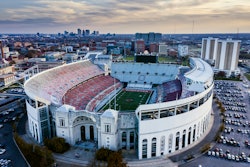Taking the best aspects of low-bid and design-build, construction management is the hottest trend in project delivery

We don't have a very good name for it yet, but there is a project development method quietly emerging in various parts of the country that promises to greatly simplify the increasingly complex job of building public sports and recreation facilities.
Known, rather awkwardly, as the Construction Manager/General Contractor method, or CM/GC, the method makes the entire construction process a whole lot more enjoyable and a whole lot less confrontational. What's more, CM/GC clients frequently get more for their money, have more flexibility, gain access to the highest-quality contractors, subcontractors and suppliers, and assume maximum control of what the facility program will include and what the facility will look like. The method is particularly well-suited for publicly funded projects with specific budgets and unique project requirements.
With so much going for it, why isn't CM/GC the project method of choice throughout the United States? Perhaps the biggest barrier to its use is the assumption that legal authority may not exist in the public arena to pursue alternatives to the traditional design-bid-build (or lowest-bid) project delivery system. While this may be true in some areas, an increasing number of clients are discovering they can indeed use CM/GC once the competitive aspects of the method are fully understood.
Key to CM/GC's success is bringing the contractor on board early to work with the owner and architect in a partnership to anticipate problems and cost-effectively develop the project from beginning to end. Contractors assume the dual role of construction manager and general contractor, managing the construction process on behalf of the owner.
Contractors are typically selected from a pre-qualified group of four to six contenders based on qualifications and fee. Qualifications include demonstrated performance in work quality, meeting schedules, budgeting, safety, community outreach and other factors. The contractor's fees are comprised of three parts:
• "Pre-construction services" fees, which cover early consultation and estimating.
• "General conditions" costs, which are proposed to provide key project staff and services.
• The contractor's profit.
These costs can be fixed at the time of contractor selection, assuring the owner of the most competitive treatment. Owners can draft their own criteria for contractor selection and performance based on the unique requirements of their project.
A guaranteed maximum price (GMP) for the contract package can be negotiated between the owner and contractor as the final design is developed if it is necessary to start construction prior to completion of the architect's drawings. The GMP essentially guarantees that the contractor will perform the defined scope of work for a certain amount of money, based on detailed confirmation of project requirements with the owner and architect. The contractor then procures subcontracts using multiple bid packages based on the final design drawings - a circumstance that allows critical work to start early. To gain the advantages of a competitive marketplace, the selection of subcontractors is frequently based on a competitive low bid, with some key skilled trades, such as pool builders, also being prequalified.
The method's collaborative approach is in stark contrast to the traditional competitive bid process, where it's everybody for him- or herself. In the design-bid-build system, the architect and owner develop design and final construction documents with little input from the construction industry. Contractor, subcontractors and suppliers are selected based on price only, and only after the architect's design documents have been completed. Fees are included in the bid price, but not disclosed separately.
By not involving the general contractor during the conceptual stages, the risk of disputes over assumptions increases, jeopardizing the project schedule and budget. This is so because architects and contractors frequently disagree on construction document interpretation, typically resulting in claims for added costs or contractor frustration over items they "missed" when setting their price. Such disagreements are minimized when the architect, contractor and owner are partners and making these assumptions together from the beginning.
CM/GC's team approach to project construction is similar in some respects to designbuild, a project delivery system that is gaining popularity in sports and recreation. [See "Design-Build Delivers," August 2001, p. 42.] Both systems call for the involvement of the general contractor early in the process. The major difference between CM/GC and designbuild is in the relative independence of architect and contractor, and the extent of owner involvement in considering choices.
While there are several variants, the most common approach to design-build involves a contractor hiring an architecture firm as a subcontractor and then agreeing to build a project at a guaranteed maximum price. The agreement is typically reached with only preliminary project requirements established and before the final design is completed. This arrangement can be effective in controlling costs by accelerating the design process. Since they are now one entity, disputes between the architect and contractor during construction are, as with CM/GC, reduced.
However, a major drawback of the designbuild approach is that it relegates the architect to a lesser role in the process, removing him or her as the independent advocate for the owner. The architect's traditional roles of exploring design choices with the owner and monitoring construction are greatly reduced. The distinctive qualities of a project's design can become compromised in this circumstance, resulting in an aesthetic sameness rather than a facility that reflects the personality of the local community. Design-build thus works best for sophisticated owners, often in large institutions, who have skilled design and construction professionals on staff.
It is probably not a huge surprise that an architect would advocate a project delivery system that maximizes the architect's role and influence over one that does not. Design-build obviously has many advantages; it is simply that CM/GC offers the benefits of the design-build and lowest-bid methods while reducing the liabilities.
CM/GC's greatest selling point is the ability of a team of co-equals to consider options throughout the design and construction process and incorporate them most effectively in the interest of the project. The CM/GC method fosters teamwork and promotes formation of non-adversarial relationships. With a better understanding of the project's scope and objectives, contractors become more flexible to changes. With less time spent haggling with the various parties, owners can become more responsive to community and user concerns during the construction process.
The CM/GC team approach clearly creates the "best value" for dollars spent during construction. This means that the various aspects of function, aesthetics, quality and cost for many design decisions are considered and decided with the owner. Work quality improves with the more cooperative relationship between the owner, architect and contractor. The contractor's influence in deciding the best way to accomplish challenging demands of the design ensures the firm's commitment to getting the best work and craft out of the entire building team.
Contractors can also identify issues not easily seen by others, such as construction impacts of building design approaches. This expertise is particularly helpful in renovation and expansion projects. Early interaction between the architect and contractor allows development of plans that precisely schedule the construction phases and can greatly minimize disruption of service and ongoing owner operations. An example is the construction of the Arvada (Colo.) Center for the Arts, where a complete renovation and doubling of facility size was accomplished with minimum down time. Careful planning of design and construction approaches allowed adequate access and space for the public and staff throughout a 15-month construction period.
Contractors brought into the project early can also review design elements and proposed construction materials and suggest alternatives that save money and time while maintaining the integrity of the project. As an example, during construction of the 160,000-square-foot Apex Center (another Arvada public facility), the architecture firm recommended constructing conventional masonry walls in building the ice rink and gymnasium spaces. However, the contractor was able to convince both the architect and the owner that precast concrete would work just as well, while accelerating the project's completion by two months. The project was therefore able to save time-driven costs, as well as costs associated with protecting masonry during the winter, without any change to the building's appearance (or its perceived quality).
Another key advantage of the CM/GC approach is that multiple "bid alternates" - optional project features that can be added if funds are available as the project progresses - can be easily used, allowing the owner to prioritize choices at advanced stages of the project. During construction of a recreation center in Golden, Colo., five valuable community wing spaces were able to be added to the project over the first months of construction as project cost requirements were confirmed.
It is in the hiring of qualified subcontractors and suppliers where the CM/GC method may have its greatest appeal to builders of sports and recreation facilities. This is so because the recreation industry is particularly susceptible to shortages of specialists qualified to build quality swimming pools, ice rinks, climbing walls and other amenities. Contractors are best positioned to understand not only the complexities of the proposed project, but also the vagaries of the local construction market in which the project is to be built. Because they are engaged from the beginning, CM/GC contractors identify required special trades early on and ensure their availability when needed. The CM/GC team is also positioned to adjust the bidding and construction schedule to get the best seasonal pricing from the subcontractor market.
During the recent construction of an aquatic park near Denver, it was discovered that demand for qualified pool subcontractors was so great that orders were backlogged for up to two years. Because the problem was identified early in the construction process, a qualified subcontractor could be selected immediately, allowing the opening target date to be met. That would not have been possible if the project's final design had been required before bidding.
For all its advantages, there are a few challenges to the CM/GC project delivery system. Diligence is required to ensure the best possible subcontractor bidding process is used, yielding good quality and competitive pricing. The owner needs to commit more time to this process than with other delivery systems, often a challenge for time-strapped recreation providers. The CM/GC method also requires that the owner be committed to a collaborative approach and work to build and maintain trust throughout the construction process.
But clearly, the benefits of the CM/GC process far outweigh the challenges. Owners find that they have the opportunity and flexibility to carefully research a variety of amenities for the facility - from leisure pools to climbing walls - and gather feedback from employees and the community. By being meaningfully involved every step of the way, owners develop a sense of pride - and, well, ownership - rarely seen with the traditional design-bid-build process. Much value is gained particularly by using CM/GC for projects such as public sports and recreation facilities that are increasingly complex, have budget limitations and require significant schedule restraints.




































